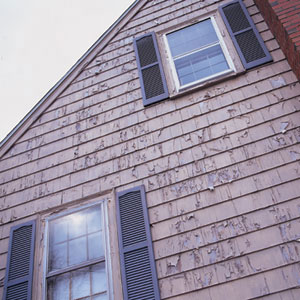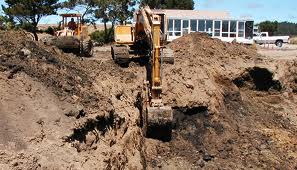How does soil become contaminated? Soil at a residential property can become contaminated when man-made chemicals come into contact with clean soil. Other sources of soil contamination may be wastes that leach from operational or closed landfills, runoff from livestock manure, direct dumping of hazardous industrial waste, waste piles from mining operations, septic systems and leach fields that breach their boundaries, and storage cisterns that burst underground.  Inspectors, as well as homeowners, should use extreme caution if they suspect that such conditions exist at a property. InterNACHI inspectors should recommend further evaluation by a qualified professional. Contaminated particles pollute soil either by becoming attached to the soil itself or by residing in the spaces between the soil particles. Sometimes, the contamination may be from a "point source," such as when pollutants are dumped directly on soil or buried underneath. In other cases, soil becomes contaminated as liquids or gasses from point sources migrate elsewhere, contaminating residential properties downstream. A less visible example of this is when a factory emits hazardous fumes out of its smokestacks, which then travel on the air and eventually fall to the ground farther away.
Inspectors, as well as homeowners, should use extreme caution if they suspect that such conditions exist at a property. InterNACHI inspectors should recommend further evaluation by a qualified professional. Contaminated particles pollute soil either by becoming attached to the soil itself or by residing in the spaces between the soil particles. Sometimes, the contamination may be from a "point source," such as when pollutants are dumped directly on soil or buried underneath. In other cases, soil becomes contaminated as liquids or gasses from point sources migrate elsewhere, contaminating residential properties downstream. A less visible example of this is when a factory emits hazardous fumes out of its smokestacks, which then travel on the air and eventually fall to the ground farther away.
The three most widespread pollutants in urban and rural residential soils are lead, arsenic and cadmium. These elements were in widespread use in paints and construction practices in the past and persist in soils today because, as heavy metals, they do not readily break down. The following is a brief description of them.
- The primary source of lead contamination in soil is from paint that contains lead. Paint residue falls to the ground and contaminates the soil as precipitation wears away a home's exterior. The area with the highest contamination and of greatest concern is the "drip zone," which extends 6 feet out from the perimeter of a home. Paint residue that fell into the soil decades ago may still persist today, even though leaded paint was banned in the late 1970s. Paint chips may also have become dislodged more recently if, for example, the home's exterior was power-washed or sand-blasted. Lead may also be deposited in soil as demolished or abandoned structures eventually fall to the ground. Another common source of lead contamination is from leaded gasoline of years past. Soil that is close to a roadway with heavy traffic has the highest risk for this type of contamination.
- Arsenic is another contaminant that is commonly found in residential soil. Arsenic was a widely used preservative for wood used in exterior structures, such as children's playgrounds, walkways and gazebos constructed from the mid- to late 1900s until 2004. Arsenic is likely to have leached into the soil surrounding these wooden structures, especially in areas that have heavy precipitation. Areas with old, abandoned wooden structures on them are of concern. Arsenic was also a common ingredient in pesticides, herbicides and fertilizers. It is likely to persist in the soil of historic orchards and agricultural areas where these chemicals have not been sprayed in decades.
- Cadmium is a common contaminant that has entered the environment and, consequently, the soil at properties as a byproduct of the burning of fossil fuels and municipal wastes, and from the smelting of zinc, lead, and copper.
Why is contaminated soil hazardous? Contaminated soil is dangerous for humans and animals. People are at high risk for poisoning when they come into direct contact with soil. This may occur when a person conducts any activity in the soil, such as digging, gardening and landscaping, and when soil is tracked into the home. Soil contaminants may be inhaled when soil is kicked up in the air, such as while mowing grass. Children are at particularly high risk because of their propensity for mouthing objects and putting their hands into their mouths without washing.
Pets and wild animals come into contact with contaminated soil when burrowing, eating and drinking from the ground. Changes in soil chemistry affect creatures at the lower end of the food chain, such as arthropods and tiny micro-organisms. Consequently, this puts entire ecosystems at risk, since it may cause a ripple effect through the food chain.
Another serious hazard is that drinking water supplies may become contaminated from contaminated soil. This is of primary concern when residents rely on underground water wells and aquifers for their fresh water supply.
There is a variety of health risks associated with contaminated soil, depending on the level of exposure, the type of pollutant, and the vulnerability of the affected population. Chronic exposure to heavy metals and other contaminants may put exposed individuals at a higher risk for cancers, neural disorders, reproductive disorders, and birth defects. Other less serious side effects may occur with light exposure, such as headaches, dizziness, fatigue and rashes. Contaminated soil also has a negative effect on plant growth and crop yields. Contaminated fruits and vegetables may be hazardous to consume, especially if they are not properly handled and washed prior to eating.
How can you tell if soil at a property is contaminated? There may or may not be visible indications of soil contamination. One obvious sign of lead contamination may be paint chips around the exterior of the house, if the paint is known to be leaded. Apparent discolorations in soil and strong odors are other indications that the soil may be hazardous. Another possible clue of contamination may be if vegetation fails to thrive in a certain area of soil, although this depends on the vegetation and whether the soil's natural content is hospitable to such growth. One of the first things to consider when trying to determine if soil is contaminated is the history of the land. If the land or adjacent areas have ever been used for agriculture, industry, mining, waste disposal or gas dispensing, then there may be a lingering problem. If there have ever been wooden structures on the property prior to the late 1970s, then the land has a higher risk for lead and arsenic contamination. The only sure way to tell if soil is contaminated is to sample the soil and have a certified laboratory test it. A certified local soils engineer or professional should be employed to conduct soil sampling. Exhaustive testing may be exorbitantly expensive, however, but tests for the most common contaminants are usually affordable. Sampling for lead, arsenic and cadmium is usually less than $100.
What are the options for remediating contaminated soil? Complete soil mapping and remediation can be a prohibitively expensive venture. Many contaminated industrial and commercial sites qualify for grants based on their "brownfield" status. However, this does not necessarily apply to residential sites. Local authorities should be consulted to see if there is financial assistance available. Funding may be provided for remediation procedures, depending on the level of risk to the surrounding community.  Soil remediation methods include the following:
Soil remediation methods include the following:
- Excavation is the most comprehensive and expensive method of remediating soil. After contaminated soil has been identified, it may be removed from the property and transferred to a landfill for disposal. New topsoil is tested, trucked in, and distributed throughout the property to replace the old soil.
- "Soil blending," whereby contaminated soil is mixed with fresh soil, results in a mix that has a lower concentration of contaminants and meets local guidelines for acceptable pollutant levels.
- The soil can be excavated, treated, and then replaced, after it has been deemed safe. Various methods for treating soil may be employed in situ or after excavation. These include applying aeration, heat and/or water, or treating it with chemicals that change the hazardous substances into ones that will biodegrade over time.
- Bioremediation is a process whereby specific plants or fungi are utilized that naturally break down hazardous materials.
- Problem areas may be covered or paved over so as to avoid exposure when excavating or treating soil is not an option. This is not a long-lasting solution, although it does help to inhibit the contaminants from spreading further.
- "Capping" is a procedure whereby problem areas are covered by more than a foot of new topsoil. This may be an adequate temporary solution but, eventually, plant roots may penetrate into the contaminated soil.
What precautions should be taken with soil that is or is suspected to be contaminated? It is important to take special precautions with contaminated soil, especially when remediation techniques are not feasible.
- Hazardous areas should be partitioned off, and direct exposure should be minimized.
- Children's play areas should be situated away from areas that may be hazardous, such as around the drip zone of a house, or near roadways where gasoline deposits may have accumulated.
- Shrubbery may be planted around the drip zone of a house to discourage traffic in that area. Consider covering bare soil with mulch if grass will not grow on patches of contaminated soil.
- Edible gardens should always be located away from hazardous areas. Building raised garden beds with clean topsoil minimizes the possibility of plants growing in unfit soil. Gardeners should always be sure to wash their hands thoroughly after working in the soil, as well as washing vegetables that will be consumed. Special attention should be paid to scraping root vegetables that have come into direct contact with contaminated soil.
- When mowing grass or working in areas with hazardous soil, wear personal protective equipment, including clothing that adequately covers exposed skin, a dust mask or respirator to prevent inhaling contaminated dirt and airborne particles, and protective eyewear.
In summary, soil may become contaminated in a myriad of ways, and special caution must be taken to minimize the associated risks. HOME INSPECTOR USA inspectors who suspect that soil or groundwater at a property is contaminated may want to recommend that their client have such conditions investigated and evaluated by a qualified soils engineer or other professional.

Comments(1)